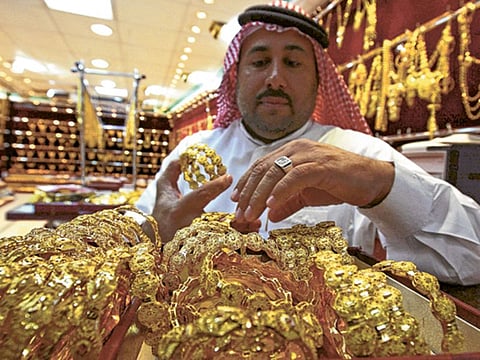Gold nears $4,000: When will prices drop next for buyers, investors?
Analysts say gold’s bull run stays strong as demand, spending, inflation risks drive highs

Dubai: Gold is testing new ground, edging towards the symbolic $4,000 an ounce and forcing investors to ask the question no one has answered convincingly in months, that is, when will it finally turn lower?
For now, momentum remains firmly with the buyers. “Trying to pick a top in gold is pretty much a fool's errand at this stage,” said Michael Brown, Senior Research Strategist at Pepperstone.
“Momentum remains firmly with the buyers, supported by a strong fundamental bull case. Demand from reserve allocators seeking diversification, the risk of inflation expectations coming loose, and runaway fiscal spending in developed markets are all driving the rally. On top of that, we are now in uncharted territory, with gold setting fresh record highs almost daily.
"Right now, the most notable levels to watch are simply the round numbers, $3,900 then $4,000, purely for psychological reasons as opposed to anything more complicated.”
Ahead of the weekend, spot gold gained 1% to $3,886 an ounce after touching a record peak of $3,898 last week. The US government shutdown added fuel to an already powerful rally.
The shutdown has stalled key economic data releases and triggered the furlough of about 750,000 federal workers at an estimated daily cost of $400 million, and has deepened the safe-haven bid. Non-yielding gold thrives when real rates fall and macro uncertainty spikes.
Is the correction coming soon?
Technically, some analysts have been calling the market overbought for weeks, but it has continued to surge. “Again it's tough to argue that the rally is 'overextended', by many metrics bullion has been 'overbought' since the start of September, yet we've rallied well over 10% since then, so gauging where we stand based on momentum metrics alone doesn't paint anything near a full picture of what's really going on,” Brown said.
“As for support, though, the prior range highs around $3,700 an ounce, followed by the 50-day moving average at $3,505 an ounce, stand as the most obvious levels to watch. So long as we remain above that latter MA, though, the over-arching trend remains to the upside.”
Goldman Sachs sees gold's rise to $4,000 per ounce driven by what it calls “conviction buyers”, which include central banks, ETFs and speculators with longer-term strategies, rather than short-term opportunistic traders.
According to the bank, every 100 tonnes of net purchases by these conviction holders typically lifts gold by about 1.7%. Central banks have been buying approximately 64 tonnes a month this year, with activity expected to reaccelerate in the autumn after a seasonal slowdown during the summer. Goldman expects the current trend in official sector accumulation to last at least another three years.
Fewer buying opportunities?
The traditional inverse link between gold and the US dollar has also weakened. “A rebound in the greenback is unlikely to derail the rally in gold to any great extent, given that the yellow metal has continued to gain ground in recent sessions, despite the buck firming against most major peers,” Brown noted.
“The same goes for the policy backdrop, though the chance of a hawkish Fed pivot is pretty remote at this stage, given that the typical inverse relationship between gold and real rates has been broken since at least mid-2022, and seems unlikely to re-establish itself any time soon.”
For now, the market remains supported by central bank buying, fiscal expansion in developed economies, and investor uncertainty over growth and inflation. Until one of those props is removed, any pullback is likely to be seen as a buying opportunity rather than the start of a deeper decline.
Sign up for the Daily Briefing
Get the latest news and updates straight to your inbox



